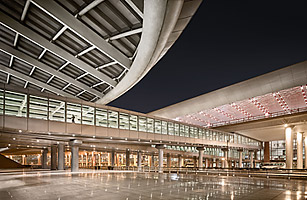
Beijing Capital International's Terminal 3 is a palace of color and light and runs like a charm
Home is not a matter of where you sleep but of where you stand. I made this curious pronouncement seven years ago at a conference next to the Dallas–Fort Worth airport (DFW), and to my surprise, the diplomats, Air Force officers, teachers and executives gathered in the room seemed largely to agree. They felt closer to fellow nomads in Singapore or Toronto, they said, than to their geographic neighbors. But when we flew away after three days of discussing global families in our hotel, I realized something even more displacing: none of us, in 72 hours, had set foot outside the airport complex, a small universe of five terminals, a 36-hole golf course and 400,000 jobs within a 5-mile (8 km) radius. No surprise. The community that has formed around the terminals — the Dallas–Fort Worth Metroplex, as it's known — is home now to 6 million people and is the fastest-growing city in the U.S.
The days when we built our airports around cities now seem distant; in the new, mobile century, we build our cities around airports. For most businesses, it's more important to be close to Bangalore or Shanghai than to be near the next suburb over. And as we complete "the annihilation of space by time" that Marx predicted, and as connectedness becomes more urgent than rootedness, airports are not just becoming cities. Cities are becoming like airports — places to leave from more than to live in.
I'd always sensed this, but it came home to me with almost shocking immediacy when I was reading the dazzling new book Aerotropolis. One of its authors, John F. Kasarda, is a business professor in North Carolina who flies from Amsterdam to Seoul preaching the gospel of building homes and businesses near airports. Co-author Greg Lindsay is a journalist who knows how to make Kasarda's research racy while raising questions about the cost of living in midair.
As Kasarda sees it, the writing's already on the screen. The third largest computer company on the planet, Lenovo, doesn't even have a corporate headquarters; its executives just orbit the globe. Two in every five IBM employees have no office. And Ram Charan, "the most influential consultant alive," in Fortune's words, had no home until he bought one (in Dallas, of course) at 67. Previously he lived entirely in hotels and on planes, sending his laundry to an office in Dallas, from which strangers sent him fresh clothes at a future destination.
Much of this is as alarming as hearing George Clooney's character in Up in the Air say, "The slower we move, the faster we die." What does a world in constant flight say about family ties and continuity? Doesn't the aerotropolitan way of life put business before humanity and convenience before community?
Aerotropolis points out that we can still address the oldest needs but in new and liberating ways: A grandmother flies to DFW every Tuesday from her home in Houston to babysit for her daughter, who is completing her medical residency. Polish surgeons commute every week to work in Nottingham, England, as fast as Brits travel on weekends to Estonia for stag parties. Yet several years ago, I spent two weeks living in and around Los Angeles' LAX to see what the global city of the future might look like. I've never been so exhausted. People were shouting, sobbing, sitting alone and confused at baggage carousels. Airport workers kept telling me how travel is etymologically related to travail. The whole experience felt as unsettling as being in a city of cranes like Beijing or Dubai.
But maybe I was drawing the wrong conclusions. Norman Foster's Terminal 3 at Beijing Capital International is larger than all five of Heathrow's terminals combined, and when you walk through the mile-long (1.6 km) dragon-headed structure, it's hard to dispute that it's infinitely more appealing than the overcrowded cities and villages all around. It was the largest airport terminal in the world until Terminal 3 in Dubai eclipsed it. Emirates Airlines not long ago boasted profits greater than those of all U.S. carriers combined. LAX, which I'd taken to be the future, is, in fact, like New York City's JFK, hopelessly lost in the past. Even as LAX is busy upgrading shuttle buses to take visitors downtown, Beijing and Dubai — like Dallas — are building whole cities in the air that allow them to take off, again and again. It's only those of us stuck on the ground, perhaps, who can't see the larger picture.
Iyer is the author of The Global Soul, about airports and movement.